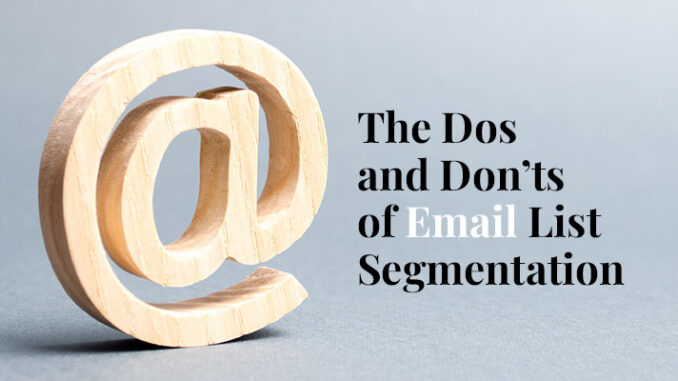
There’s an oft-quoted statistic in digital marketing circles that the ROI for email marketing is upwards of $36 for every $1 spent. It’s a powerful one, to be sure — but it doesn’t tell the whole story.
A stellar email ROI doesn’t come simply from tossing out the same email to every person on your list. In fact, 58% of all revenue earned from email campaigns comes from segmented, targeted or personalized emails.
And according to Mailchimp, segmented email campaigns boast a 14.31% higher open rate and a 100.95% higher click-through rate than non-segmented campaigns.
What is email segmentation? Email segmentation is the process of dividing your email subscribers into smaller, more targeted groups based on specific criteria.
The power of segmenting your email list comes from the ability to personalize communication to groups of customers with similar goals, interests and motivations. In turn, this drives higher engagement, fosters stronger customer relationships and ultimately boosts your overall marketing performance.
Pretty great, right?
To help you get started, this post will cover some dos and don’ts when it comes to email list segmentation.
Do: Embrace a Content-Driven Approach
Segmentation is a powerful tool, but if your email content is lackluster, no amount of segmenting is going to get through to your target audience.
At madison/miles media, we embrace a content-driven approach to digital marketing because we believe getting the message right is more important than nailing the delivery. When you embrace a content-driven approach, you’ll deliver personalized and valuable content that deeply connects with your target audience. To do this, focus on:
Do: Identify Your Target Audience
Knowing and understanding your target audience is one of the keys to success across all digital marketing efforts. Without a clear understanding of what motivates your would-be customers, creating personalized and relevant content tailored to their needs, preferences and interests is nearly impossible.
Start by gathering basic demographic information about your target audience. Who are your current customers? Where do they live? How old are they? What do they do for work?
Demographic data is a great starting point, but you shouldn’t stop there. That’s because demographics alone can’t paint a complete picture of your audience’s behaviors and motivations, which are crucial for creating highly targeted and engaging email campaigns.
This brings us to our first don’t.
Don’t: Rely Solely on Demographics for Segmentation
Relying solely on demographics for segmentation can lead to missed opportunities and less effective marketing campaigns. To truly connect with your audience and create meaningful segments, it’s essential to incorporate behavioral and psychographic data into your segmentation strategy.
Behavioral data includes things like how and when subscribers interact with your content — be it email, website, product information, etc. It includes things such as their browsing and purchase history, email engagement and content preferences. Psychographic data digs deep into the attitudes, values, beliefs and motivations of a customer.
Behavior plus psychographic data equals a rounder, more accurate picture of who your customer is. This can lead to more effective and personalized email campaigns that resonate and drive results.
Do: Use Dynamic Lists
The difference between dynamic and static lists is like a playlist that updates automatically based on your listening preferences, compared to your first-generation iPod that played the same songs until you uploaded new ones.
To avoid getting stuck in 2008, opt for dynamic lists for your email campaigns. (And Spotify personal playlists for your listening pleasure.)
Dynamic lists ensure that subscribers are accurately sorted into appropriate segments as their preferences and behaviors change. As a result, dynamic lists make for a more personalized experience for email recipients and a much more efficient and streamlined process for you. And that pays off big.
Don’t: Over-Segment Your List
Obviously, we’re pro-segmentation, but as with anything, you can take it too far.
The more groups you have, the more content you need to create. Say you have a dozen different segments; that means 12 drafts of the same email, just slightly changed to fit each list. Not only does this sound exhausting, but it’s also not really a great use of your marketing efforts and could diminish your ROI.
Do: Automate
Email automation is exactly what it sounds like: It’s the process of using software to streamline, automate and optimize the creation, sending and tracking of email campaigns. Using tools like HubSpot’s workflows, you can send emails to segments of your list at predetermined times based on specific actions, behaviors or events.
A good example of this is our own Marketing Gaps Quiz. Check out how we use automation and segmentation to meet prospects where they are and send them content designed specifically for them.
Don’t: Skip List Hygiene
Use all that valuable data to keep your email list clean. Why? Regular list hygiene means fewer bouncebacks, higher engagement rates and a clearer, more accurate picture of the efficacy of your email marketing strategy.
Here are a few tips for keeping your list clean:
These dos and don’ts for email list segmentation can significantly boost your digital marketing campaigns, thereby driving higher engagement and fostering stronger customer relationships. And, if you’re looking for some expert support in harnessing the power of segmentation, we’re here to help.

Leave a Reply